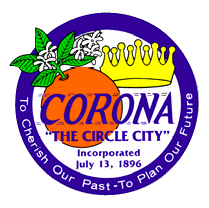Many of my posts start off something like this: “I was looking at this map and I noticed something odd…” Right, that’s how it’s going to go today too. In this instance I was geo-tagging a pile of old photographs I’d scanned and loaded into iPhoto. Then I stumbled upon a perfect little circle of very unusual diameter in Southern California.
A Big Circle
As I drilled down from space it blossomed into Grand Boulevard. The City of Corona sat squarely in the bull’s eye.
The size of the circle is peculiar for a couple of reasons. First, I haven’t seen many ring roads of this approximate diameter and level of perfection. I’ve certainly found my fair share of smaller loops such as roundabouts or traffic circles. I’ve even driven double-roundabouts such as this particularly evil one shown below outside of Brisbane, Australia on the way to Mount Coot-tha several years ago. Here’s that awful thing:
I realize the European and Australian readers are laughing at this point because roundabouts are an integral part of daily life. However, this is unusual for many of us in North America. Consider further that driving on the left side of the road would get me arrested back home. It’s was traumatic.
There’s Bigger of Course
I’ve also experienced much larger rings like the ones that bypass large cities. Lord knows I’ve spent untold hours sitting on this particular circle, the infamous Washington “Beltway” (map) in all sorts of horrific traffic conditions.

A medium-sized circle like the one in Corona, however, is a bit of a stranger to me. Even so I tried to tease a little normalcy out of it. So I figuring I could probably align it to some standard or unit like a mile or a kilometre. Unfortunately the diameter didn’t seem to match an integer or even a common fractional approximation of either unit as I eyeballed the situation. I was completely confounded.
Math?
It’s necessary to go back to what we learned in Middle School. Let’s use the equation for the circumference of a circle (C=2?r). Remember thinking back in those days that you’d never need geometry and promptly forgot about it? Me too. As it turns out, here we find a real-world application. This forms a nice, precise three mile circumference if you believe the city. Obviously I didn’t get in my car and drive it so let’s take them at their word.
I still can’t explain why the street pattern didn’t run North-South / East-West either. Instead it’s as if someone rotated the circle slightly clockwise. Then they put a weird jog in Main Street smack in the middle. It’s so precise in some respects, yet so flawed in others. Crazy.
Driving along Grand Boulevard. Notice the gentle curvature on the horizon
Of course I had to find out more about the entire situation, and thankfully the City’s website provides a little clarity.
“Taylor hired Anaheim engineer H. C. Kellogg to design a circular Grand Boulevard three miles round. Early residents used to parade their fancy buggies on this circular street that enclosed the main functions of the community: schools, churches, residences and stores… The name ‘Corona’ was suggested, standing for the circle within the City and the connotative crown.”
It Gets More Interesting
Corona has many different dictionary meanings including circle and crown, as well as the fuzzy halo of light that appears around the moon during a total solar eclipse. It’s also a beer made in Mexico with a crown on the label and a lime sticking out the top. (1)

The article goes on to explain further that international automobile races were held on Grand Boulevard in 1913, 1914, and 1916. They drew crowds of up to 100,00 people to a town of only 4,000. The city halted races thereafter because it was too expensive and, well, deaths resulted from the 1916 event. It does seem to be just about racetrack size. However, I don’t see any banked curves so maybe that was for the best.

What I found particularly interesting is that the city apparently derived its name from the shape of the road rather than the other way around. The theme subsequently carried forward to the city seal and even to its nickname, Circle City. Are there other places where this has happened? Are there other perfect little rings like this? Let me know and I’ll add a map in the comments section.
That can’t possibly be a common occurrence, but then again, it’s not a common road.
12MC Loves Footnotes!
(1) I attended a beer lecture a number of years ago given by the late Michael Jackson (the beer writer not the one-gloved wonder, although that would probably have been just as entertaining if not more so now that I think about it). At the conclusion he took questions from the audience, and someone asked him to name what he considered to be the worst beer on the planet. Without even a millisecond of a hesitation he answered, “Corona”. When pressed for an explanation, and in consideration of the multitude of beers to choose from, he explained that Corona probably starts out tasting like any other mass-marketed light lager. However it begins to degrade the second it leaves the assembly line. The clear bottles allow ultraviolet light to penetrate into the beverage unimpeded. So it continues to degrade while traveling great distance to market.

Leave a Reply